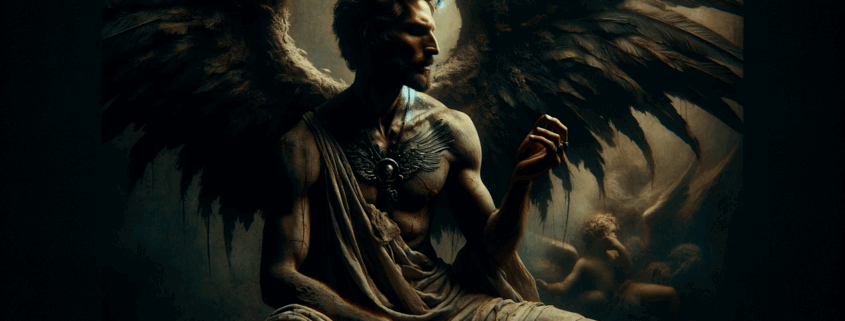Lucifer
Lucifer. Origins, Meaning & Misunderstood Symbolism
Lucifer is a name that stirs emotion like no other. Often associated with evil, rebellion, or darkness, the name has long carried intense spiritual and cultural weight. But beneath the fear and controversy lies a much older and more complex story.
Where does the term come from? And how did its meaning evolve from “light-bringer” to symbol of darkness?
In this article, we peel back the layers of myth and misunderstanding to examine the true origin and symbolism of Lucifer—from classical Latin to esoteric tradition.
To explore the topic in full depth, we recommend the revealing presentation:
🎥 Lucifer: Bringer of the New Age (DVD)
The Word “Lucifer”: What It Actually Means
Let’s begin with the basics: the word “Lucifer” is Latin. It comes from:
Lux = Light
Ferre = To bring or carry
So literally, Lucifer means “light-bearer” or “bringer of light.”
In ancient Rome, “Lucifer” was not a demon. It was the name for the morning star—what we now know as the planet Venus when it appears before sunrise.
Roman poets, including Cicero and Ovid, used the word “Lucifer” to poetically describe dawn or light rising in darkness. It carried positive, even divine connotations.
So how did this beautiful metaphor for light become a name associated with evil?
Biblical Misinterpretation and Translation
The dramatic shift in Lucifer’s meaning comes largely from a mistranslation of scripture, particularly in the Book of Isaiah (14:12). The King James Version reads:
“How art thou fallen from heaven, O Lucifer, son of the morning!”
However, in the original Hebrew, the word used was “Helel ben Shachar,” which means “shining one, son of the dawn.”
When the Bible was translated into Latin, St. Jerome rendered Helel as “Lucifer.” At the time, the word still just meant “morning star.” There was no implication that this being was Satan.
Over the centuries, however, this poetic image of a fallen star became linked to the devil, largely through evolving theology and popular belief—not from the original text itself.
Lucifer ≠ Satan (Originally)
In fact, Lucifer and Satan were originally two different ideas. In the Bible:
Satan appears in the Book of Job as an adversary, a kind of prosecutor.
Lucifer appears only once—in Isaiah—and it refers to a fallen Babylonian king, not a cosmic rebel.
The fusion of the two figures came much later, influenced by church doctrine, apocalyptic literature, and even works like Dante’s Inferno and Milton’s Paradise Lost.
This blending of names and ideas created a new archetype: a fallen angel, cast down for pride, now ruling the underworld.
But as history shows, this version of Lucifer is theological mythology—not original scripture or linguistic fact.
The Occult and Esoteric Meaning of Lucifer
In occult and esoteric circles, Lucifer has a very different meaning. Here, Lucifer represents:
Enlightenment
Knowledge
Rebellion against tyranny
The quest for personal sovereignty
This version of Lucifer is not worshiped as a deity, but respected as a symbol of inner illumination—the archetypal light-bearer who challenges ignorance.
Some traditions even view Lucifer as a cosmic teacher, much like Prometheus, who brought fire to humanity in Greek mythology.
This interpretation doesn’t deny the power of the symbol—but it repositions it: from demon to divine rebel, and from evil to misunderstood.
Jordan Maxwell explores this symbolic inversion in detail in the video:
📀 Lucifer: Bringer of the New Age (DVD)
The Venus Connection: Morning Star as Cosmic Symbol
Lucifer’s ancient association with Venus is not incidental. Venus, as the morning star, rises before the sun, heralding the dawn. Across cultures, this celestial body was revered as:
The light before the light
A symbol of transition, from darkness to illumination
A guide between realms (earth and heaven, matter and spirit)
In this light, the Lucifer archetype takes on a cosmic role—not as a destroyer, but as a revealer. The light-bearer becomes a force that awakens, stirs, and challenges.
Of course, not all traditions see this as good. With light comes responsibility. With knowledge comes judgment. And with awakening comes the end of illusions.
Lucifer in Secret Societies and Modern Philosophy
Lucifer’s image appears frequently in the writings of Freemasonry, Theosophy, and other secret traditions. Often, he represents the pursuit of hidden knowledge, and the liberation of the mind.
Writers like Manly P. Hall and Madame Blavatsky referenced Lucifer symbolically—as a being or energy that stands for:
Truth in the face of dogma
Knowledge in the age of control
Freedom against imposed ignorance
This symbolism does not imply worship or adoration—it suggests recognition. That Lucifer, as a mythic idea, expresses the human struggle for wisdom in a world often built on deception.
Why the Name Still Matters
Whether seen as angel, adversary, or symbol, Lucifer remains a name with deep resonance. Its legacy tells us:
Words and names evolve, and with them, meaning and power.
History is written by interpretation, not always fact.
Symbolism matters, especially when hidden in plain sight.
Understanding the roots of the name helps us understand how narratives are shaped, how fears are manufactured, and how symbols are co-opted over time.
The true story is not just theological—it’s linguistic, cultural, and psychological.
Final Thoughts: From Demon to Light-Bearer
Once a poetic name for Venus, it was was never originally evil. His fall from grace came not from heaven, but from centuries of reinterpretation and fear-based doctrine.
By reclaiming the true meaning of the name, we are not embracing darkness—we are clarifying what light actually means.
For those seeking the unfiltered history and symbolic truth behind Lucifer, we highly recommend:
🎥 Lucifer: Bringer of the New Age (DVD)






